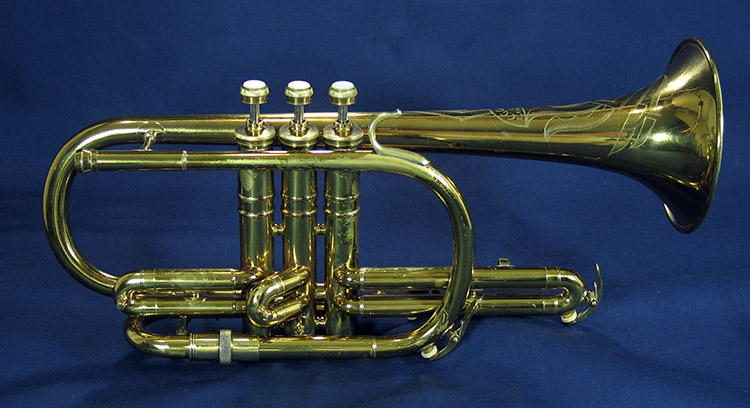Conn 36A Concert Grand

Date: 1940. Owner unknown. Photo courtesy Don "Relic" Rugg
Notice the tuning slide which curves around the valve casing. It enters the third valve on the left hand side of the instrument. The main tuning slide is adjusted using a microtuner. Taken together this is an unusual configuration. Also notice the lack of a 3rd slide finger ring. It isn't missing, it was never there. Many older models cornet don't have a 3rd slide finger ring. The player was expected to "bend" the notes into tune using the lips. The 36A has bottom spring valves. Quite an interesting instrument, the 36A.
The Conn 36A Concert Grand is most probably a copy of the King Master, which was made between 1917 and 1965. The King Master had a "medium" bore on the 1934 model, which I gather translates to 0.458". The 36A's shape is identical to that of the King Master including the microtuner.
The 36A Concert Grand was produced between at least 1940 and 1950. However, it wasn't yet in production in April 1938. Production probably continued to 1951. There is at least one 36A with a serial number dating to 1942, during world war two. The 36A is a #2 bore, which is 0.468".
I have learned that the third slide without the finger ring to adjust the pitch of a low D and C# is slightly longer than it is on modern instruments. On modern instruments the low Eb is in tune, but the low D and C# are quite sharp. On these older cornets with the longer third slide and no finger ring the Eb is a bit flat and the D and C# are slightly sharp, but not as sharp as they are on later instruments. It was thought that the flat Eb and slightly sharp D and C# were within the abilities of the player to lip into tune.
As far as I can tell at this point, all Conn cornets built before 1955 take a short shank cornet mouthpiece as opposed to the 2¾" "Bach-style" long shank cornet mouthpiece. The long shank cornet mouthpieces will fit a pre-1955 Conn cornet, but won't give the proper intonation or playing characteristics of a short shank cornet mouthpiece. All of Conn's "Connstellation" cornet mouthpieces are long shank mouthpieces. The "standard" (my term) Conn mouthpieces such as the Conn 4 are long shank if there is a "ridge" halfway down the shank, and short shank if there is no ridge. Also, the long shank mouthpieces have "Conn" and the number of the mouthpiece stamped across the mouthpiece, whereas the short shank mouthpieces have it stamped along the length of the mouthpiece. All Conn cornet mouthpieces built before the "standard" series, such as the "Wonder" and "AI-412" are short shank mouthpieces.
What Conn said in 1941:
The 36-A Concert Grand cornet was designed expressly for the band and for the cornet soloist. Built in medium bore, it is
easy to play but has a surprisingly big tone. It is short and wide, affording a comfortable hand hold and giving perfect
balance while being played.
The long, uninterupted sweep of mouthpipe contributes to the accurate scale and easy response. The bell has a large throat
which helps give the round, full mellow tone that distinguishes this model. It is amazingly flexible in both upper and lower
registers. Clickless Crysteel valves. This model, priced so economically is destined to become one of the most popular models
Conn has ever built. Built in Bb and A.
What Conn said in 1950:
The medium bore, Bb-A 36A model is short and wide, for comfort and balance in holding. The long, uninterupted
sweep of mouthpipe contributes to its accuracy of scale and ease of response. Large throat of bell gives round,
mellow tone.